Reliability Evaluation of Smart Microgrids Considering Cyber Failures and Disturbances under Various Cyber Network Topologies and Distributed Generation’s Scenarios
Abstract
:1. Introduction
- Proposing a new MCS-based reliability evaluation of CPMGs that considers all cyber faults and interruptions, i.e., information transmission errors, routing errors, and delay of information channels;
- Considering the MGCC faults’ impacts on CPMG’s reliability;
- Simulating the uncertainties of the physical system of CPMG, e.g., stochastic behaviors of wind turbine (WT) and photovoltaic (PV)outputs;
- Studying the CPMG’s reliability under different cyber network topologies, including cyber network topologies with the redundancies of the MGCC;
- An analysis of the CPMG’s reliability under various DG scenarios;
- Sensitivity analyses to gain insight into how the cyber failures and interruptions might affect the CPMG’s reliability.
2. CPMG’s Architecture
- The gathering of DGs and loads information by the MCs and LCs, respectively;
- Transmitting the information through the information channel connecting the MGCC, MCs, and LCs;
- Checking of the power balance condition and other operation aspects by the MGCC;
- Adopting orders based on information received, such as increasing power generation or decreasing power in the supply side, and load management strategies on the demand side;
- Transmitting the commands generated by the MGCC using the information channel between the MGCC, MCs, and LCs; and
- Executing the MGCCs’ generated commands by local controllers.
- Information transmission faults: It is essential to receive the correct information from the sensors and control units for the MGCC to make correct decisions [28]. Hence, the information transmission faults might lead to incorrect decisions. Consequently, the appropriate operation of the CPMG and its stability might be threatened.
- Routing faults: The CPMG equipment’s real-time operation needs to receive the correct information package. Therefore, routing faults in the sending or receiving of the information package might affect the instantaneous function of the control and cyber systems [29]. Hence, the CPMG is influenced by routing faults.
- Delay in data transfer: The fast performance of cyber elements and information channels is crucial to meet power balance conditions in CPMGs. Therefore, a delay in data transfer could cause a lack of timely communication between the control units, resulting in a loss of power balance [30].
| CPMG Layers | Sub-system | Stochastic Parameter | Uncertainties’ Source | Probability Distribution |
|---|---|---|---|---|
| Physical network | WT | WT output power | Wind speed variability | Weibull [15] |
| TTF | Random failure | Exponential [16] | ||
| TTR | ||||
| PV | PV output power | Solar irradiation variability | Beta [15] | |
| TTF | Random failure | Exponential [13] | ||
| TTR | ||||
| MT | TTF | Random failure | Exponential [16] | |
| TTR | ||||
| Bus | TTF | Random failure | Exponential [16] | |
| TTR | ||||
| ESS | TTF | Random failure | Exponential [16] | |
| TTR | ||||
| Demand-side | Load value | Consumption variability | Normal [32] | |
| Cyber network | MGCC | TTF | Random failure | Exponential [13] |
| TTR | ||||
| Information channel | TTF | Random failure | Exponential [16] | |
| TTR | ||||
| Switch | TTF | Random failure | Exponential [16] | |
| TTR | ||||
| Information terminal | TTF | Random failure | Exponential [16] | |
| TTR | ||||
| Information transmission delay | Delay time in information transmission proses | Random amount | Exponential [33,34] | |
| Information transmission | Payload error | Random fault | Gaussian white noise (GWN) [35,36] | |
| Header error | Random fault | GWN [35,36] |
3. Modeling of the Proposed Reliability Evaluation of CPMGs
3.1. Cyber–Physical Interdependencies Due to Cyber Failures
3.2. Information Transmission Errors and Delays
3.3. Stochastic Simulation of Renewable-Based DGs
3.4. Stochastic Simulation of Loads
3.5. Reliability Calculations
4. Test Results and Discussions
- Scenario 1 (WT-100): In the first scenario, only a WT with a maximum capacity of 50 kW is considered as the renewable DG of the CPMG.
- Scenario 2 (PV-100): In the second scenario, only a PV with a maximum capacity of 50 kW is considered as the renewable DG of the CPMG.
- Scenario 3 (Wt-50/PV-50): In the third scenario, a PV with a maximum capacity of 25 kW and a WT with a maximum capacity of 25 kW are considered as the hybrid renewable DGs of the CPMG.
5. Conclusions
Author Contributions
Funding
Institutional Review Board Statement
Informed Consent Statement
Data Availability Statement
Conflicts of Interest
Nomenclature
| Indices | |
| Index of each control cycle time (t = 1: 8760 × T) | |
| Index of CPMG’s states (i = 1: NMS) | |
| Index of physical elements (k = 1: NP) | |
| Index of cyber elements (l = 1: NC) | |
| Index of generators (l = 1: Ng) | |
| Index of system elements numbers (j = 1: NP + NC) | |
| Index of information channel (f = 1: NIch) | |
| Index of cyber sender terminal (y = 1: NCST) | |
| Index of cyber receiver terminal (z = 1: NCRT) | |
| Index of power sender terminal (q = 1: NPST) | |
| Index of power receiver terminal (r = 1: NPRT) | |
| Parameters | |
| Power–power interconnection | |
| Cyber–power interdependency | |
| Power–cyber interconnection | |
| Cyber–cyber interconnection | |
| Updated power–power interconnection after mapping the cyber failures to physical system | |
| Updated cyber–power interdependency after mapping the cyber failures to physical system | |
| Updated power–cyber interconnection after mapping the cyber failures to physical system | |
| Updated cyber–cyber interconnection after mapping the cyber failures to physical system | |
| Updated power–power interconnection after considering the destroyed interconnections due to cyber/physical failures | |
| Updated cyber–power interdependency after considering the destroyed interconnections due to cyber/physical failures | |
| Updated power–cyber interconnection after considering the destroyed interconnections due to cyber/physical failures | |
| Updated cyber–cyber interconnection | |
| Beta probability density function (PDF) parameters | |
| Failure rate | |
| Repair rate | |
| Shape and scale parameters in wind speed’s Weibull CDF | |
| Wind turbine cut-in speed (m/s) | |
| Wind turbine cut-off speed (m/s) | |
| Wind turbine rated speed (m/s) | |
| Coefficient of current temperature (A/°C) | |
| Solar cell temperature (°C) | |
| Ambient temperature (°C) | |
| Extraterrestrial solar irradiance (kW/m2) | |
| Solar cell nominal operating temperature (°C) | |
| Photovoltaic modules short circuit current (A) | |
| Photovoltaic modules open circuit voltage (V) | |
| Coefficient of voltage temperature (V/°C) | |
| Number of photovoltaic modules | |
| Efficiency of photovoltaic inverter | |
| Probability of payload error | |
| Probability of header error | |
| Cyber sending terminal | |
| Power sending terminal | |
| Cyber receiving terminal | |
| Power receiving terminal | |
| Shortest path function | |
| Average value of delays based on historical data | |
| Mean value of power demand | |
| Time interval | |
| Mean time to failure | |
| Mean time to repair | |
| Variables | |
| CPMG’s system state | |
| The state of CPMG element | |
| The state of CPMG element | |
| Availability probability | |
| Unavailability probability | |
| Cyber–physical interdependencies matrix | |
| Updated cyber–physical interdependencies matrix after mapping the cyber failures to corresponding physical element | |
| Updated cyber–physical interdependencies matrix after applying the destroyed interconnections due to cyber/physical failures | |
| Power channel | |
| Information channel | |
| The random variables uniformly distributed in (0 1) | |
| Microgrid graph | |
| Time to failure | |
| Time to repair | |
| Wind speed (m/s) | |
| Weibull cumulative density function (CDF) of wind speed | |
| Wind turbine output power (W) | |
| Wind turbine rated output power (W) | |
| Gamma probability distribution function | |
| Clearness index value | |
| Irradiance on a horizontal plane and extraterrestrial total solar irradiance (kW/m2) | |
| Photo voltaic modules output current (A) | |
| Photovoltaic modules output voltage (V) | |
| Photovoltaic module output power (W) | |
| Payloads of the information channel at the sending terminal | |
| Payloads of the information channel at the recieving terminal | |
| Received packet data | |
| Sent packet data | |
| Payload error | |
| Header error | |
| Header of the information channel at the sending terminal | |
| Header of the information channel at the recieving terminal | |
| Delay | |
| Electrical demand | |
| Electrical loss | |
| Electrical generated power | |
| Difference between the generation and load demand | |
| Load curtailment | |
| At-risk state | |
| Information channel state | |
| Expected energy not supplied | |
| Loss of load probability | |
| System average interruption duration index | |
| Abbreviations | |
| PV | Photovoltaic |
| WT | Wind turbine |
| MT | Micro turbine |
| DG | Distributed generations |
| MCS | Monte Carlo Simulations |
| CDF | Cumulative distribution function |
| CPS | Cyber–physical system |
| EENS | Expected energy not supplied |
| ESS | Energy storage system |
| LOLP | Loss of load probability |
| SAIDI | System average interruption duration index |
| MGCC | Microgrid control center |
| SW | Network switch |
| PCC | Point of common coupling |
| MC | Microunit controller |
| LC | Load controller |
| TTF | Time to failure |
| TTR | Time to repair |
| MTTR | Mean time to repair |
| MTTF | Mean time to failure |
| CST | Cyber sender terminal |
| CRT | Cyber receiver terminal |
| PST | Power sender terminal |
| PRT | Power receiver terminal |
| SMG | Smart microgrid |
| CPMG | Cyber–power microgrid |
| P-Table | Probability table |
| GWN | Gaussian white noise |
| CPIM | Cyber–physical interdependencies matrix |
| SPF | Shortest path function |
| Pch | Power channel |
| Ich | Information channel |
References
- Suman, G.K.; Guerrero, J.M.; Roy, O.P. Optimisation of Solar/Wind/Bio-generator/Diesel/Battery Based Microgrids for Rural Areas: A PSO-GWO Approach. Sustain. Cities Soc. 2021, 67, 102723. [Google Scholar] [CrossRef]
- Nasiraghdam, H.; Safari, A. Techno-economic assessment of combined power to hydrogen technology and hydrogen storage in optimal bidding strategy of high renewable units-penetrated microgrids. Sustain. Energy Technol. Assess. 2020, 42, 100832. [Google Scholar] [CrossRef]
- Emmanouil, S.; Philhower, J.; Macdonald, S.; Khadim, F.K.; Yang, M.; Atsbeha, E.; Nagireddy, H.; Roach, N.; Holzer, E.; Anagnostou, E.N. A Comprehensive Approach to the Design of a Renewable Energy Microgrid for Rural Ethiopia: The Technical and Social Perspectives. Sustainability 2021, 13, 3974. [Google Scholar] [CrossRef]
- Jimada-Ojuolape, B.; Teh, J. Surveys on the reliability impacts of power system cyber–physical layers. Sustain. Cities Soc. 2020, 62, 102384. [Google Scholar] [CrossRef]
- Gandhi, I.; Ravi, L.; Vijayakumar, V.; Subramaniyaswamy, V. Improving security for wind energy systems in smart grid applications using digital protection technique. Sustain. Cities Soc. 2020, 60, 102265. [Google Scholar] [CrossRef]
- Phommixay, S.; Doumbia, M.L.; Cui, Q. A two-stage two-layer optimization approach for economic operation of a microgrid under a planned outage. Sustain. Cities Soc. 2021, 66, 102675. [Google Scholar] [CrossRef]
- Mansour-Saatloo, A.; Mirzaei, M.A.; Mohammadi-Ivatloo, B.; Zare, K. A Risk-Averse Hybrid Approach for Optimal Participation of Power-to-Hydrogen Technology-Based Multi-Energy Microgrid in Multi-Energy Markets. Sustain. Cities Soc. 2020, 63, 102421. [Google Scholar] [CrossRef]
- Habibzadeh, H.; Nussbaum, B.H.; Anjomshoa, F.; Kantarci, B.; Soyata, T. A survey on cybersecurity, data privacy, and policy issues in cyber-physical system deployments in smart cities. Sustain. Cities Soc. 2019, 50, 101660. [Google Scholar] [CrossRef]
- Ding, X.; Guo, Q.; Qiannan, T.; Jermsittiparsert, K. Economic and environmental assessment of multi-energy microgrids under a hybrid optimization technique. Sustain. Cities Soc. 2021, 65, 102630. [Google Scholar] [CrossRef]
- Moazeni, F.; Khazaei, J. Optimal operation of water-energy microgrids; a mixed integer linear programming formulation. J. Clean. Prod. 2020, 275, 122776. [Google Scholar] [CrossRef]
- Geng, S.; Wu, G.; Tan, C.; Niu, D.; Guo, X. Multi-Objective Optimization of a Microgrid Considering the Uncertainty of Supply and Demand. Sustainability 2021, 13, 1320. [Google Scholar] [CrossRef]
- Wang, J.; Gao, X.; Sun, Z. A Multilevel Simulation Method for Time-Variant Reliability Analysis. Sustainability 2021, 13, 3646. [Google Scholar] [CrossRef]
- Guo, J.; Zhao, T.; Liu, W.; Zhang, J. Reliability Modeling and Assessment of Isolated Microgrid Considering Influences of Frequency Control. IEEE Access 2019, 7, 50362–50371. [Google Scholar] [CrossRef]
- Hashemi-Dezaki, H.; Askarian-Abyaneh, H.; Shams-Ansari, A.; DehghaniSanij, M.; Hejazi, M.A. Direct cyber-power interdependencies-based reliability evaluation of smart grids including wind/solar/diesel distributed generations and plug-in hybrid electrical vehicles. Int. J. Electr. Power Energy Syst. 2017, 93, 1–14. [Google Scholar] [CrossRef]
- Hashemi-Dezaki, H.; Agah, S.M.M.; Askarian-Abyaneh, H.; Haeri-Khiavi, H. Sensitivity analysis of smart grids reliability due to indirect cyber-power interdependencies under various DG technologies, DG penetrations, and operation times. Energy Convers. Manag. 2016, 108, 377–391. [Google Scholar] [CrossRef]
- Wang, C.; Zhang, T.; Luo, F.; Li, F.; Liu, Y. Impacts of Cyber System on Microgrid Operational Reliability. IEEE Trans. Smart Grid 2019, 10, 105–115. [Google Scholar] [CrossRef]
- Falahati, B.; Fu, Y.; Wu, L. Reliability assessment of smart grid considering direct cyber-power interdependencies. IEEE Trans. Smart Grid 2012, 3, 1515–1524. [Google Scholar] [CrossRef]
- Falahati, B.; Fu, Y. Reliability assessment of smart grids considering indirect cyber-power interdependencies. IEEE Trans. Smart Grid 2014, 5, 1677–1685. [Google Scholar] [CrossRef]
- Zhu, W.; Han, M.; Milanovic, J.V.; Crossley, P. Methodology for Reliability Assessment of Smart Grid Considering Risk of Failure of Communication Architecture. IEEE Trans. Smart Grid 2020, 11, 4358–4365. [Google Scholar] [CrossRef]
- Barani, M.; Vadlamudi, V.V.; Heegaard, P.E. Reliability analysis of cyber-physical microgrids: Study of grid-connected microgrids with communication-based control systems. IET Gener. Transm. Distrib. 2020, 15, 645–663. [Google Scholar] [CrossRef]
- Karimipour, H.; Dehghantanha, A.; Parizi, R.M.; Choo, K.K.R.; Leung, H. A Deep and Scalable Unsupervised Machine Learning System for Cyber-Attack Detection in Large-Scale Smart Grids. IEEE Access 2019, 7, 80778–80788. [Google Scholar] [CrossRef]
- Stamp, J.; McIntyre, A.; Ricardson, B. Reliability impacts from cyber attack on electric power systems. In Proceedings of the 2009 IEEE/PES Power Systems Conference and Exposition PSCE 2009, Seattle, WA, USA, 15–18 March 2009; pp. 1–8. [Google Scholar] [CrossRef]
- Wang, L.; Jiao, S.; Xie, Y.; Mubaarak, S.; Zhang, D.; Liu, J.; Jiang, S.; Zhang, Y.; Li, M. A Permissioned Blockchain-Based Energy Management System for Renewable Energy Microgrids. Sustainability 2021, 13, 1317. [Google Scholar] [CrossRef]
- Martinez-Bolaños, J.; Silva, V.; Zucchi, M.; Heideier, R.; Relva, S.; Saidel, M.; Fadigas, E. Performance Analysis of Topologies for Autonomous Hybrid Microgrids in Remote Non-Interconnected Communities in the Amazon Region. Sustainability 2021, 13, 44. [Google Scholar] [CrossRef]
- Wu, G.; Li, M.; Li, Z.S. Resilience-Based Optimal Recovery Strategy for Cyber–Physical Power Systems Considering Component Multistate Failures. IEEE Trans. Reliab. 2020, 1–15. [Google Scholar] [CrossRef]
- Sadik, S.; Ahmed, M.; Sikos, L.F.; Islam, A.K.M.N. Toward a Sustainable Cybersecurity Ecosystem. Computers 2020, 9, 74. [Google Scholar] [CrossRef]
- Andronie, M.; Lăzăroiu, G.; Iatagan, M.; Hurloiu, I.; Dijmărescu, I. Sustainable Cyber-Physical Production Systems in Big Data-Driven Smart Urban Economy: A Systematic Literature Review. Sustainability 2021, 13, 751. [Google Scholar] [CrossRef]
- Wang, Q.; Cai, X.; Tang, Y.; Ni, M. Methods of cyber-attack identification for power systems based on bilateral cyber-physical information. Int. J. Electr. Power Energy Syst. 2021, 125, 106515. [Google Scholar] [CrossRef]
- Gao, X.; Peng, M.; Tse, C.K. Cascading Failure A nalysis of Cyber Physical Power Systems Considering Routing Strategy. IEEE Trans. Circuits Syst. II Express Briefs 2021, 1. [Google Scholar] [CrossRef]
- Wang, Y.; Nguyen, T.L.; Xu, Y.; Shi, D. Distributed control of heterogeneous energy storage systems in islanded microgrids: Finite-time approach and cyber-physical implementation. Int. J. Electr. Power Energy Syst. 2020, 119, 105898. [Google Scholar] [CrossRef]
- Rotar, R.; Jurj, S.L.; Opritoiu, F.; Vladutiu, M. Fault Coverage-Aware Metrics for Evaluating the Reliability Factor of Solar Tracking Systems. Energies 2021, 14, 1074. [Google Scholar] [CrossRef]
- Hariri, A.M.; Hashemi-Dezaki, H.; Hejazi, M.A. A novel generalized analytical reliability assessment method of smart grids including renewable and non-renewable distributed generations and plug-in hybrid electric vehicles. Reliab. Eng. Syst. Saf. 2020, 196, 106746. [Google Scholar] [CrossRef]
- Park, J.W.; Lee, J.M. Transmission modeling and simulation for Internet-based control. In Proceedings of the IECON’01. 27th Annual Conference of the IEEE Industrial Electronics Society (Cat. No.37243), Denver, CO, USA, 29 November–2 December 2001; Volume 1, pp. 165–169. [Google Scholar] [CrossRef]
- Tipsuwan, Y.; Chow, M.Y. Gain scheduler middleware: A methodology to enable existing controllers for networked control and teleoperation—Part I: Networked control. IEEE Trans. Ind. Electron. 2004, 51, 1218–1227. [Google Scholar] [CrossRef] [Green Version]
- Rojas, A.J. Feedback control over signal-to-noise ratio constrained communication channels with channel input quantisation. In Proceedings of the 2010 American Control Conference ACC 2010, Baltimore, MD, USA, 30 June–2 July 2010; pp. 265–270. [Google Scholar] [CrossRef]
- Xin, S.; Guo, Q.; Sun, H.; Zhang, B.; Wang, J.; Chen, C. Cyber-Physical Modeling and Cyber-Contingency. IEEE Trans. Smart Grid 2015, 6, 2375–2385. [Google Scholar] [CrossRef]
- Chehri, A.; Fofana, I.; Yang, X. Security Risk Modeling in Smart Grid Critical Infrastructures in the Era of Big Data and Artificial Intelligence. Sustainability 2021, 13, 3196. [Google Scholar] [CrossRef]
- Zhao, S.; Yan, X.; Wang, B.; Wang, E.; Ma, L. Research on reliability evaluation method of DC circuit breaker based on Markov model. Electr. Power Syst. Res. 2019, 173, 1–5. [Google Scholar] [CrossRef]
- Hariri, A.-M.; Hejazi, M.A.; Hashemi-Dezaki, H. Investigation of impacts of plug-in hybrid electric vehicles’ stochastic characteristics modeling on smart grid reliability under different charging scenarios. J. Clean. Prod. 2021, 287, 125500. [Google Scholar] [CrossRef]
- Blokus, A.; Dziula, P. Relations of Imperfect Repairs to Critical Infrastructure Maintenance Costs. Sustainability 2021, 13, 4917. [Google Scholar] [CrossRef]
- Kim, W.; Eom, H.; Kwon, Y. Optimal Design of Photovoltaic Connected Energy Storage System Using Markov Chain Models. Sustainability 2021, 13, 3837. [Google Scholar] [CrossRef]
- Hashemi-Dezaki, H.; Hariri, A.-M.; Hejazi, M.A. Impacts of load modeling on generalized analytical reliability assessment of smart grid under various penetration levels of wind/solar/non-renewable distributed generations. Sustain. Energy Grids Netw. 2019, 20, 1–16. [Google Scholar] [CrossRef]
- Arya, L.D.; Choube, S.C.; Arya, R.; Tiwary, A. Evaluation of reliability indices accounting omission of random repair time for distribution systems using Monte Carlo simulation. Int. J. Electr. Power Energy Syst. 2012, 42, 533–541. [Google Scholar] [CrossRef]
- Bellavista, P.; Giannelli, C.; Mamei, M.; Mendula, M.; Picone, M. Application-driven Network-aware Digital Twin Management in Industrial Edge Environments. IEEE Trans. Ind. Inform. 2021, 1. [Google Scholar] [CrossRef]
- Song, J.; Lee, Y.; Choi, J.-W.; Gil, J.-M.; Han, J.; Choi, S.-S. Practical In-Depth Analysis of IDS Alerts for Tracing and Identifying Potential Attackers on Darknet. Sustainability 2017, 9, 262. [Google Scholar] [CrossRef] [Green Version]
- Vahid-Pakdel, M.J.; Nojavan, S.; Mohammadi-ivatloo, B.; Zare, K. Stochastic optimization of energy hub operation with consideration of thermal energy market and demand response. Energy Convers. Manag. 2017, 145, 117–128. [Google Scholar] [CrossRef]
- Hashemi-Dezaki, H.; Hamzeh, M.; Askarian-Abyaneh, H.; Haeri-Khiavi, H. Risk management of smart grids based on managed charging of PHEVs and vehicle-to-grid strategy using Monte Carlo simulation. Energy Convers. Manag. 2015, 100, 262–276. [Google Scholar] [CrossRef]
- Faraji, J.; Hashemi-Dezaki, H.; Ketabi, A. Optimal probabilistic scenario-based operation and scheduling of prosumer microgrids considering uncertainties of renewable energy sources. Energy Sci. Eng. 2020, 8, 3942–3960. [Google Scholar] [CrossRef]
- Yona, A.; Senjyu, T.; Funabashi, T. Application of Recurrent Neural Network to Short-Term-Ahead Generating Power Forecasting for Photovoltaic System. In Proceedings of the 2007 IEEE Power Engineering Society General Meeting, Tampa, FL, USA, 24–28 June 2007; pp. 1–6. [Google Scholar]
- Memari, M.; Karimi, A.; Hashemi-Dezaki, H. Reliability evaluation of active distribution networks based on scenario reduction method using PSO algorithm. In Proceedings of the 2020 10th Smart Grid Conference (SGC), Kashan, Iran, 16–17 December 2020; pp. 1–6. [Google Scholar]
- Available online: http://www.satba.gov.ir (accessed on 17 May 2021).
- Kounev, V.; Tipper, D.; Yavuz, A.A.; Grainger, B.M.; Reed, G.F. A Secure Communication Architecture for Distributed Microgrid Control. IEEE Trans. Smart Grid 2015, 6, 2484–2492. [Google Scholar] [CrossRef]
- Zheng, L.; Parkinson, S.; Wang, D.; Cai, L.; Crawford, C. Energy efficient communication networks design for demand response in smart grid. In Proceedings of the 2011 International Conference on Wireless Communications and Signal Processing (WCSP), Nanjing, China, 9–11 November 2011. [Google Scholar] [CrossRef]
- Shafiee, Q.; Guerrero, J.M.; Vasquez, J.C. Distributed secondary control for islanded microgrids-a novel approach. IEEE Trans. Power Electron. 2014, 29, 1018–1031. [Google Scholar] [CrossRef] [Green Version]
- Wang, Y.; Li, W.; Lu, J.; Liu, H. Evaluating multiple reliability indices of regional networks in wide area measurement system. Electr. Power Syst. Res. 2009, 79, 1353–1359. [Google Scholar] [CrossRef]
- Wang, Y.; Li, W.; Lu, J. Reliability analysis of phasor measurement unit using hierarchical markov modeling. Electr. Power Compon. Syst. 2009, 37, 517–532. [Google Scholar] [CrossRef]
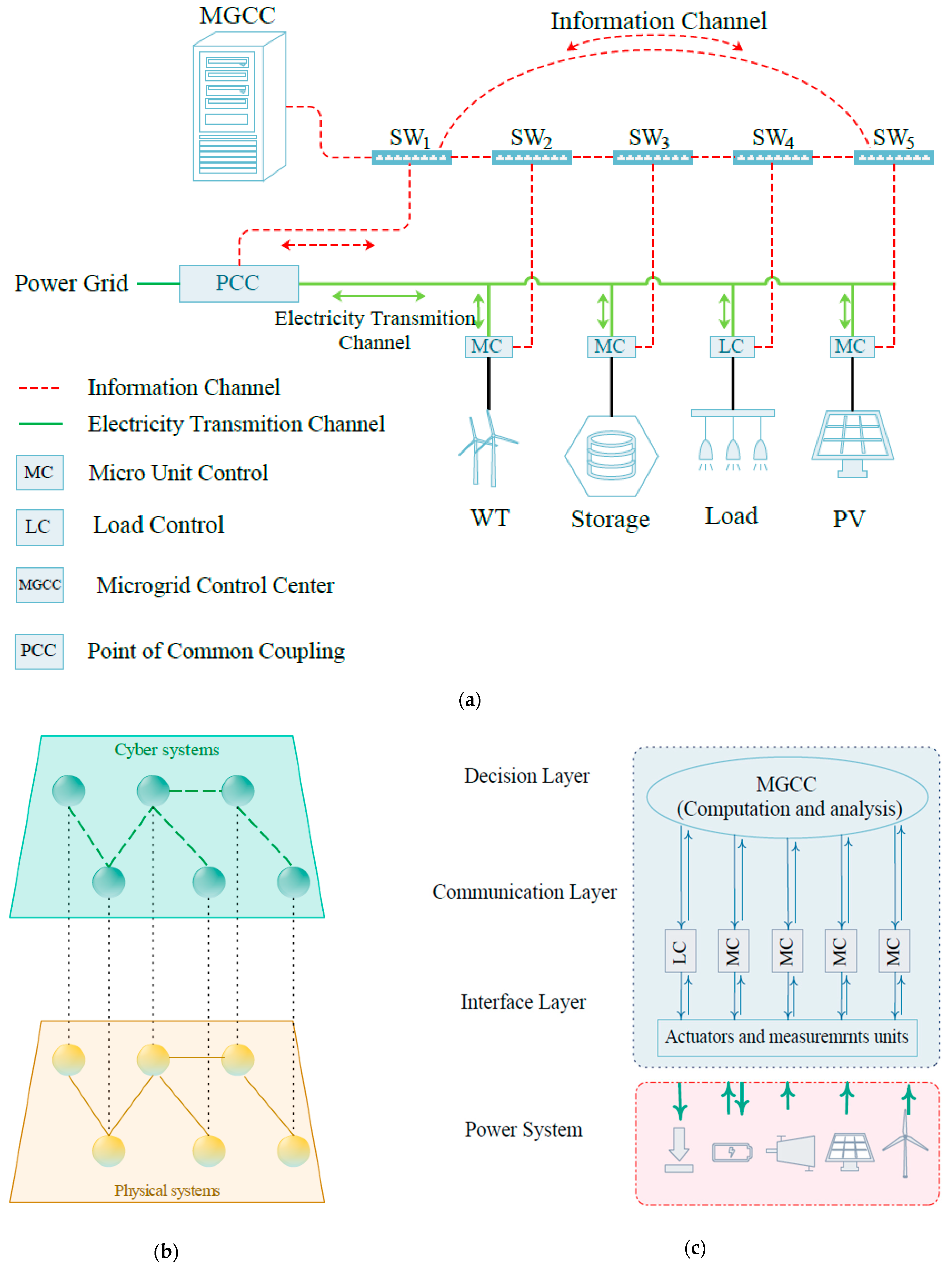
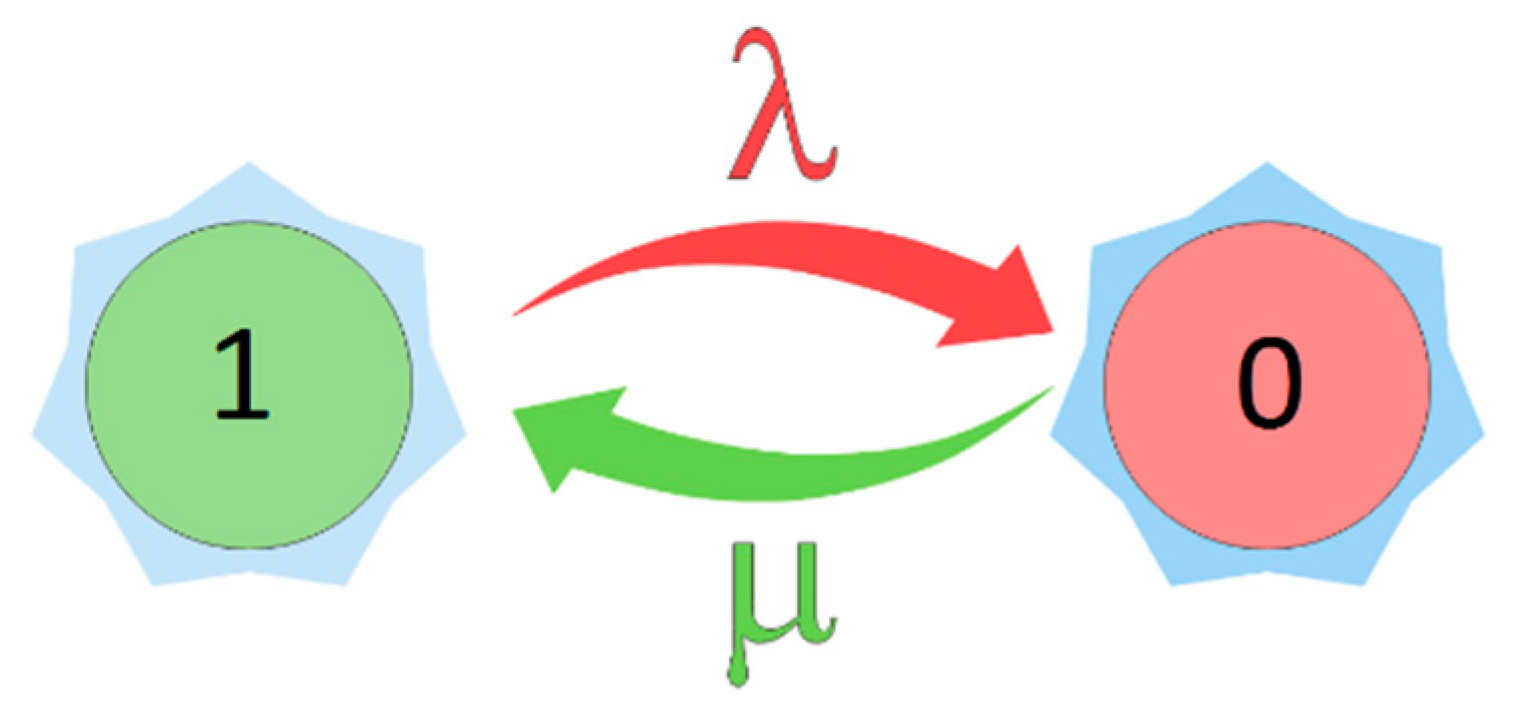
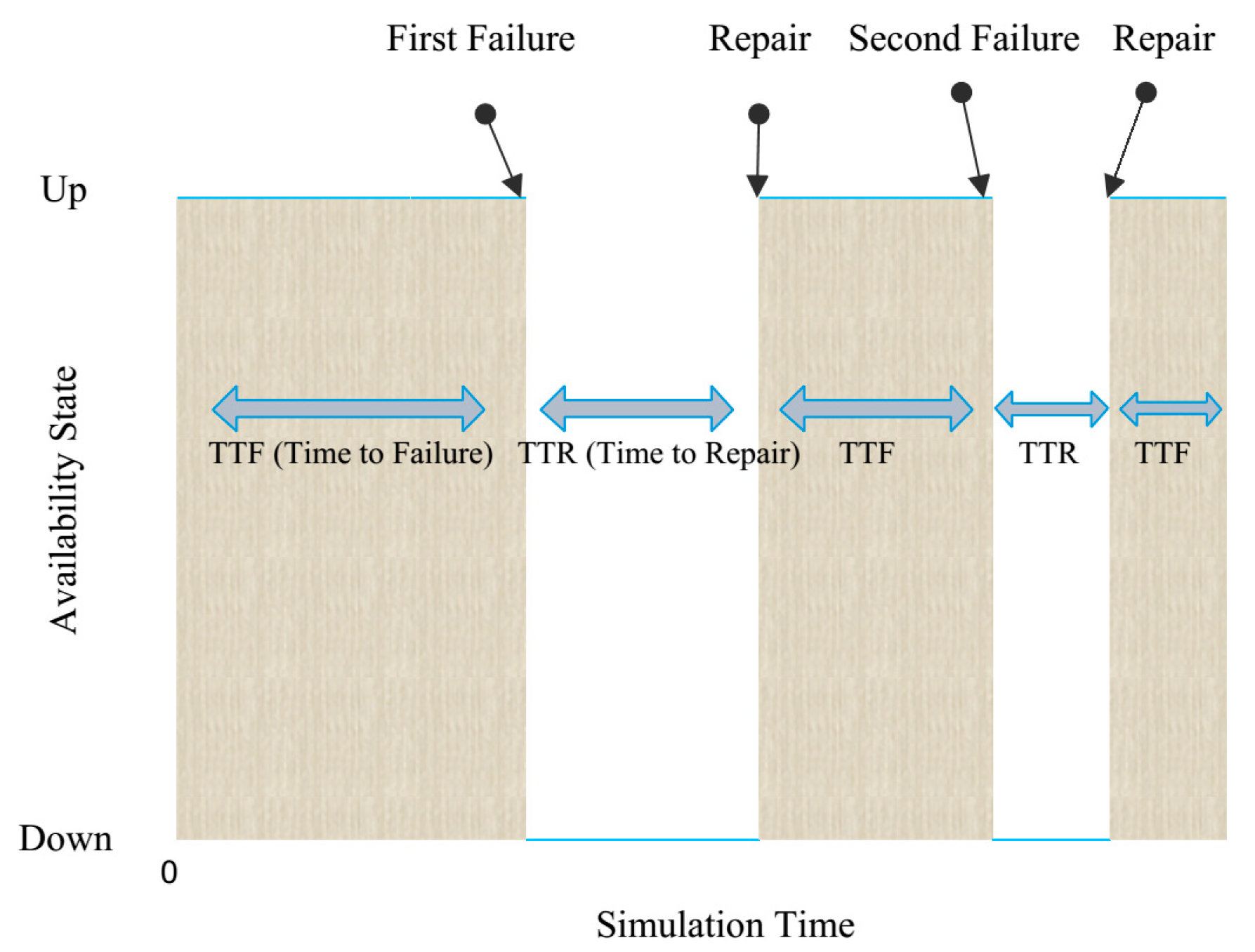
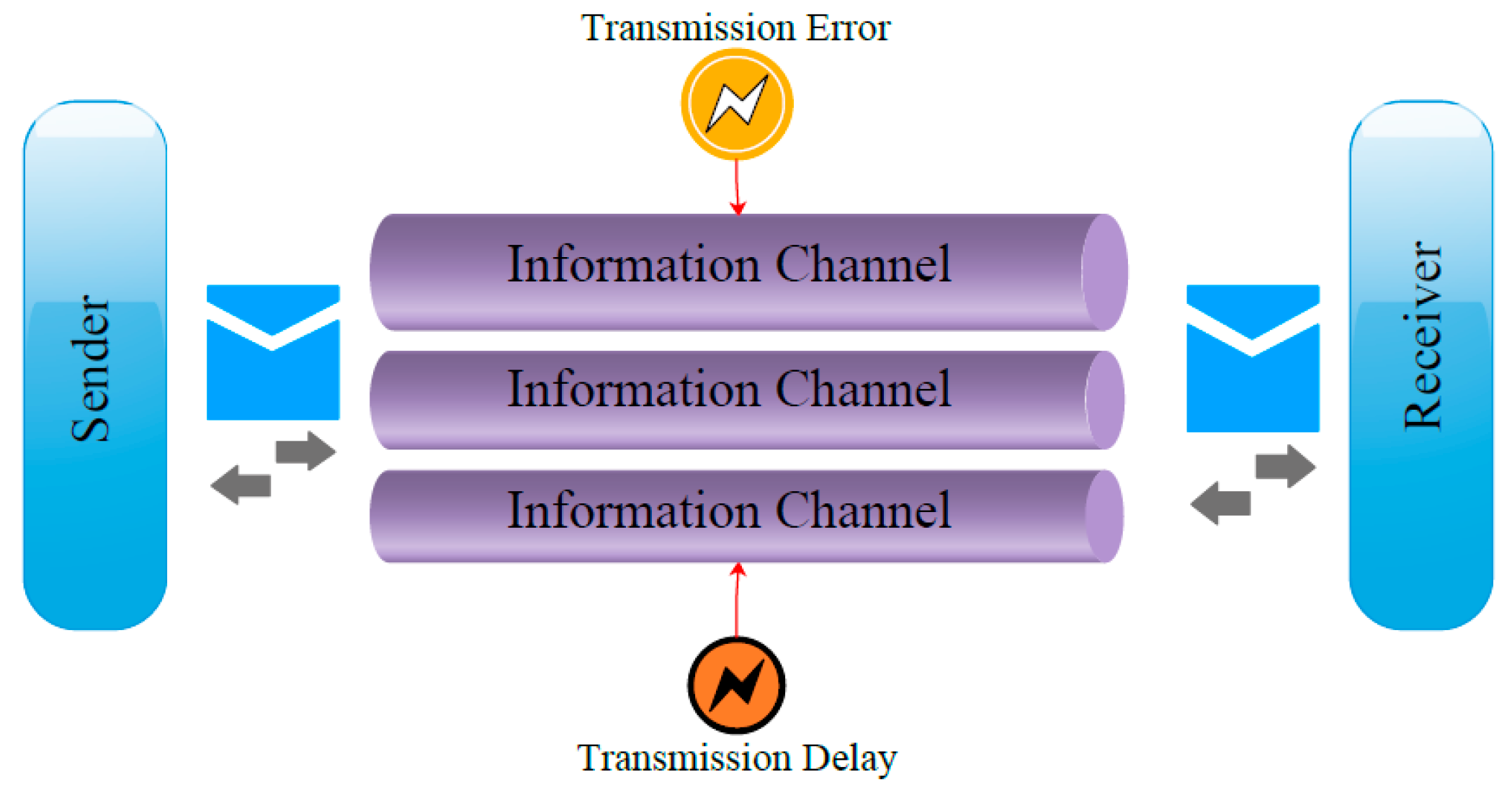
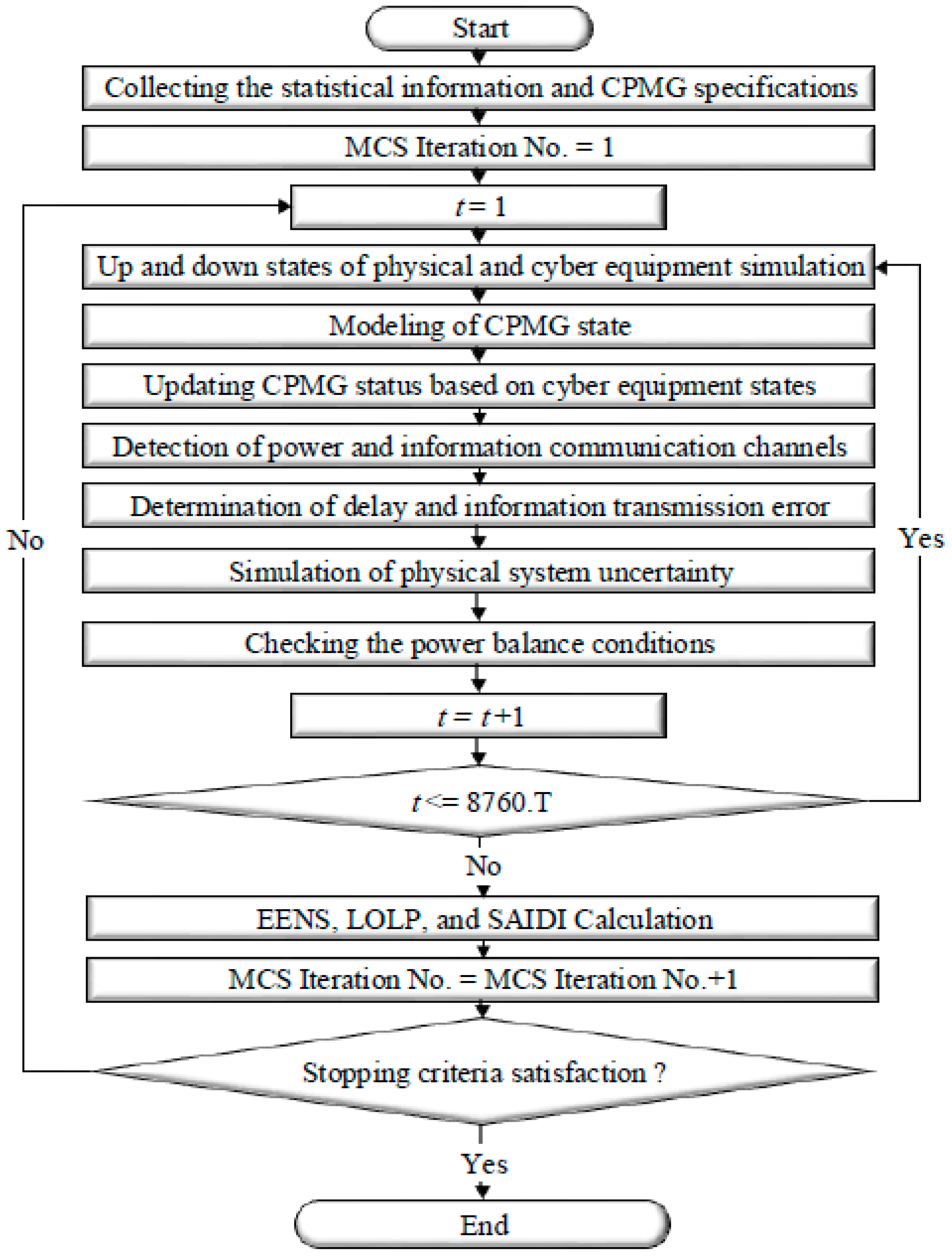
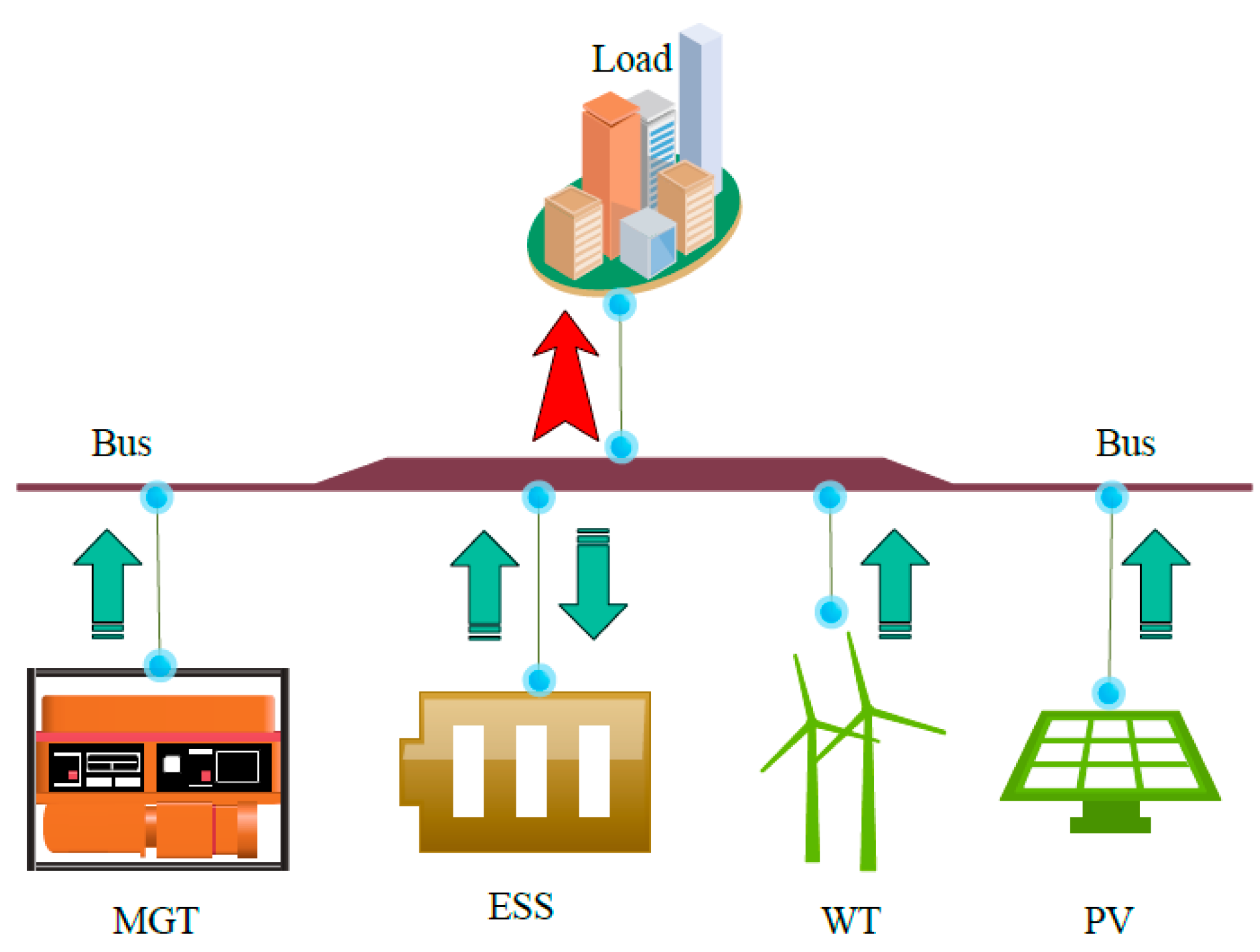
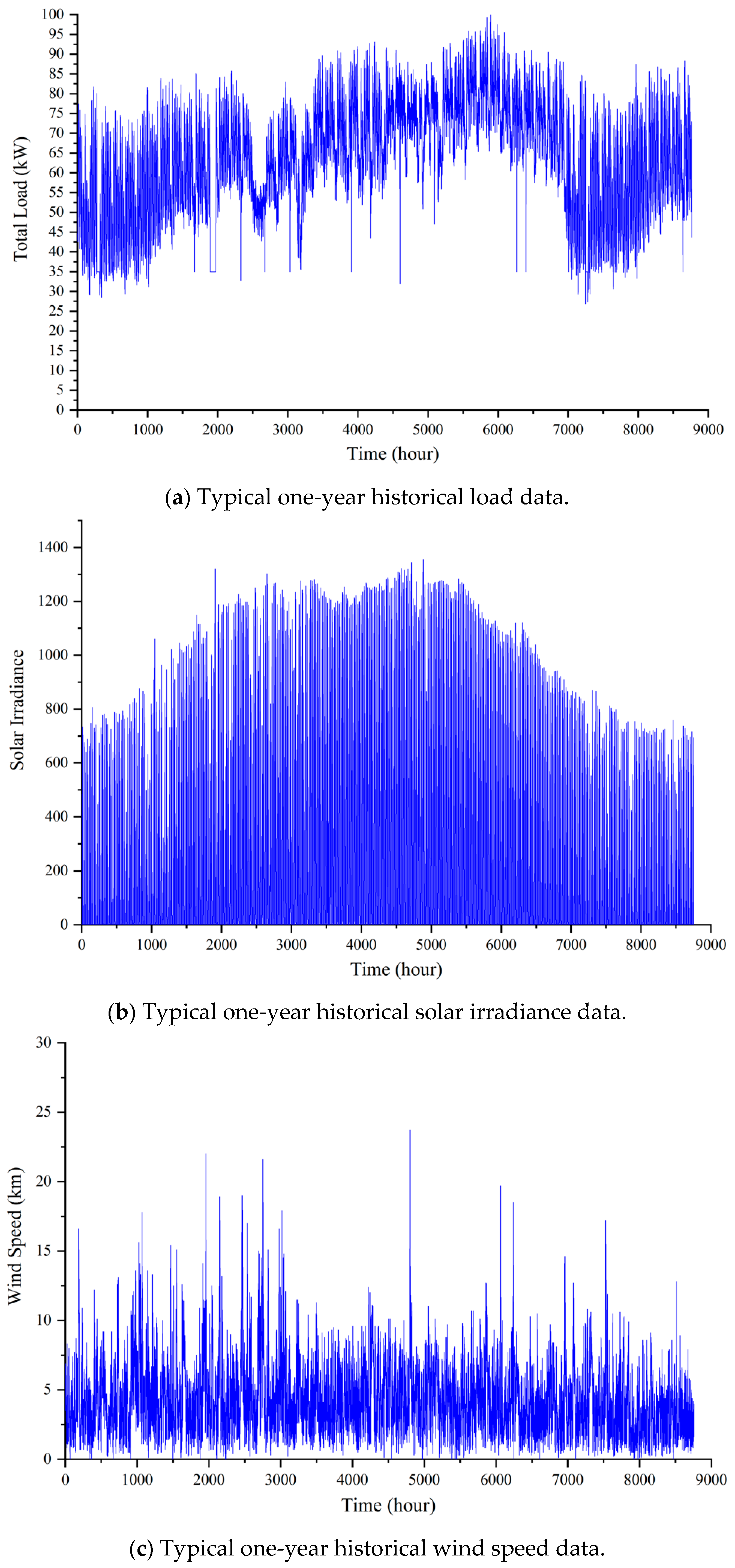
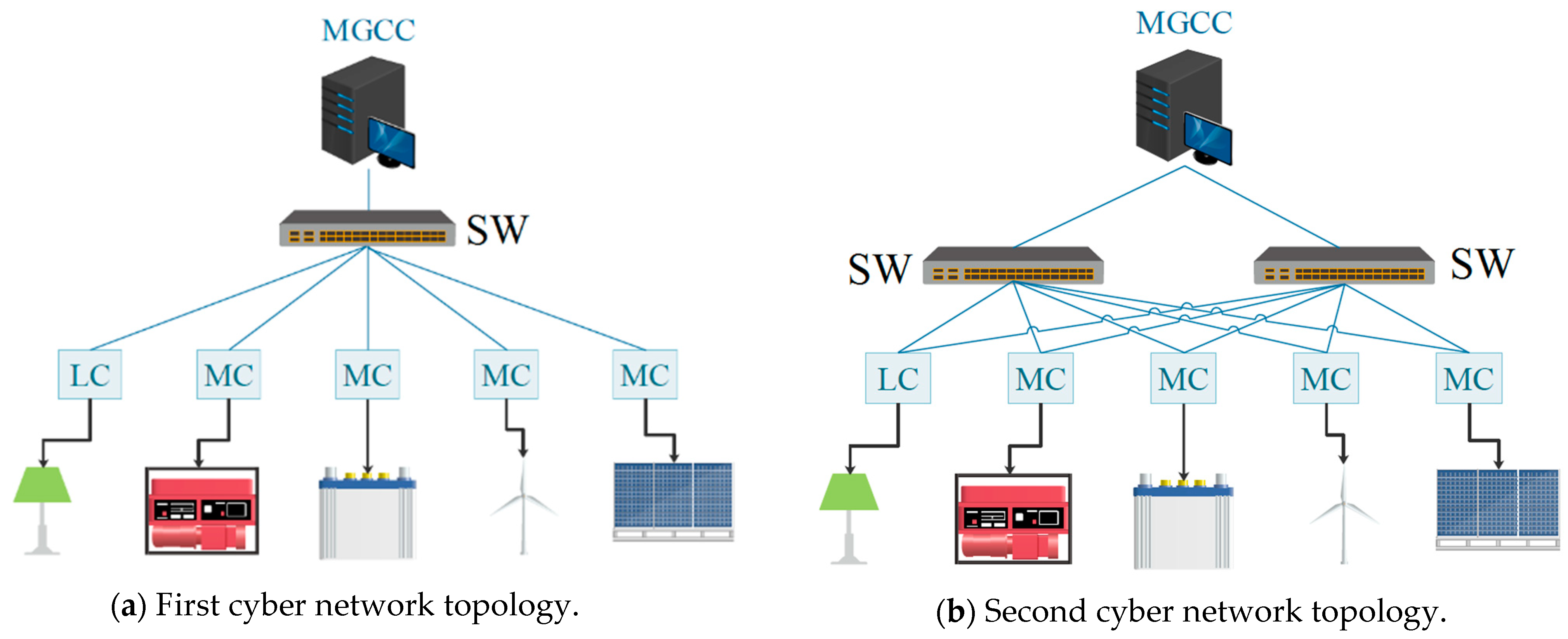
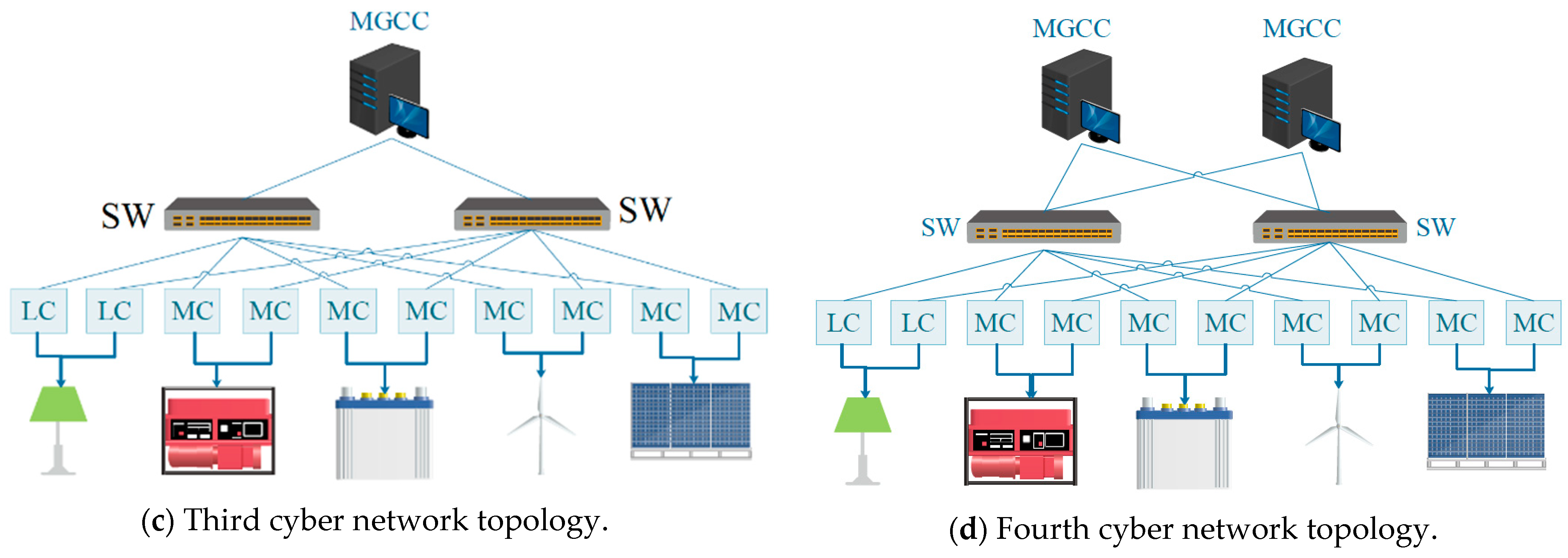

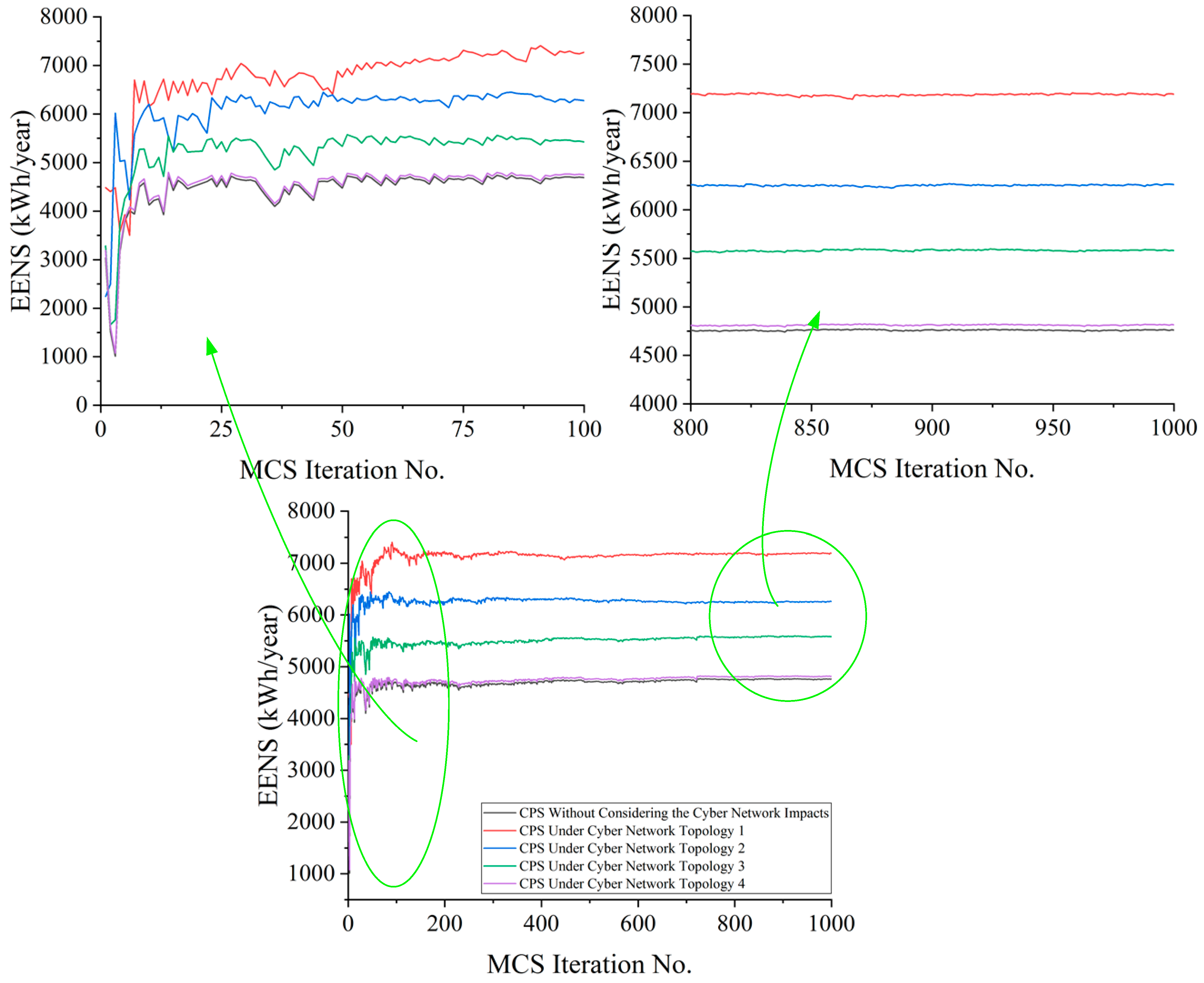
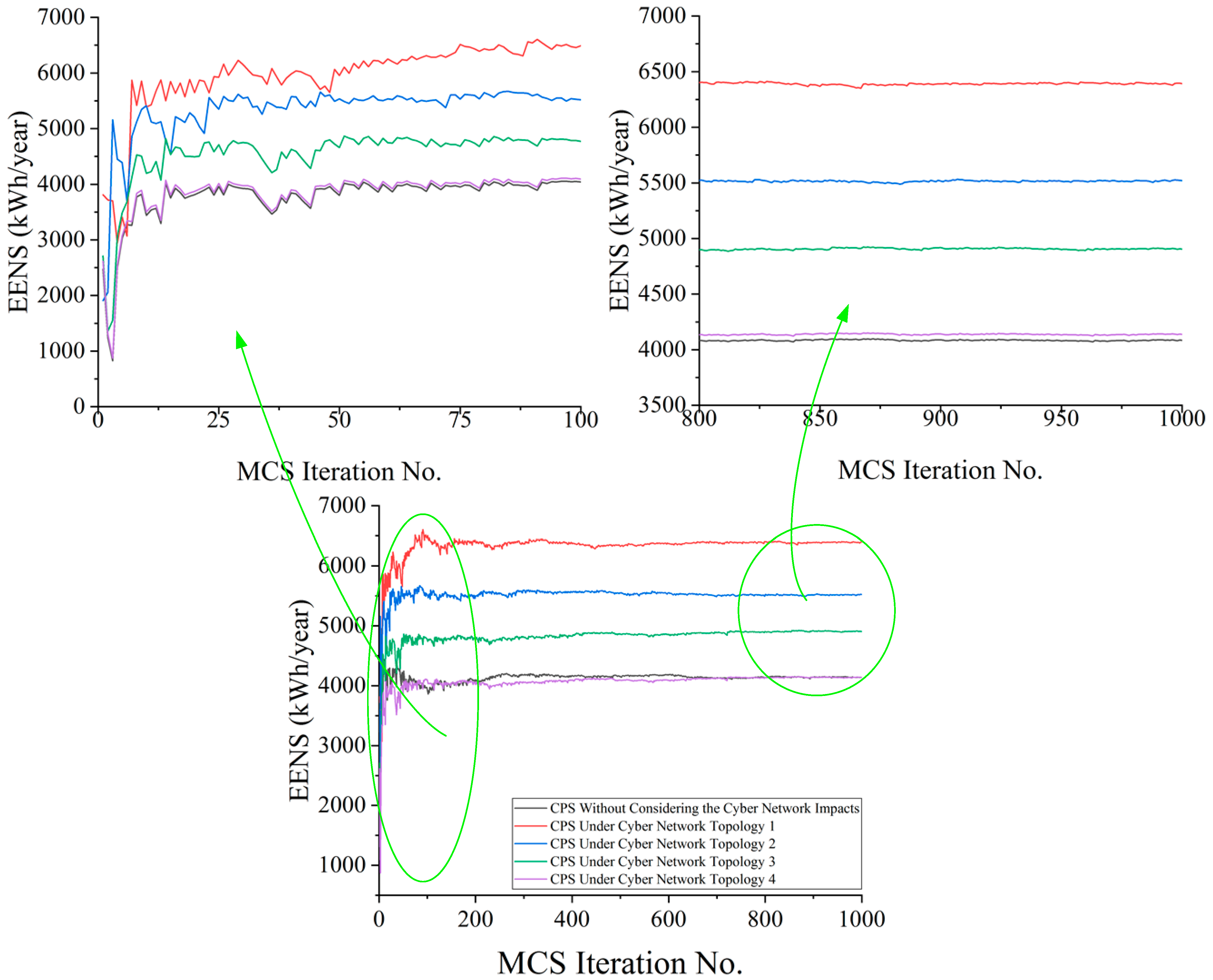

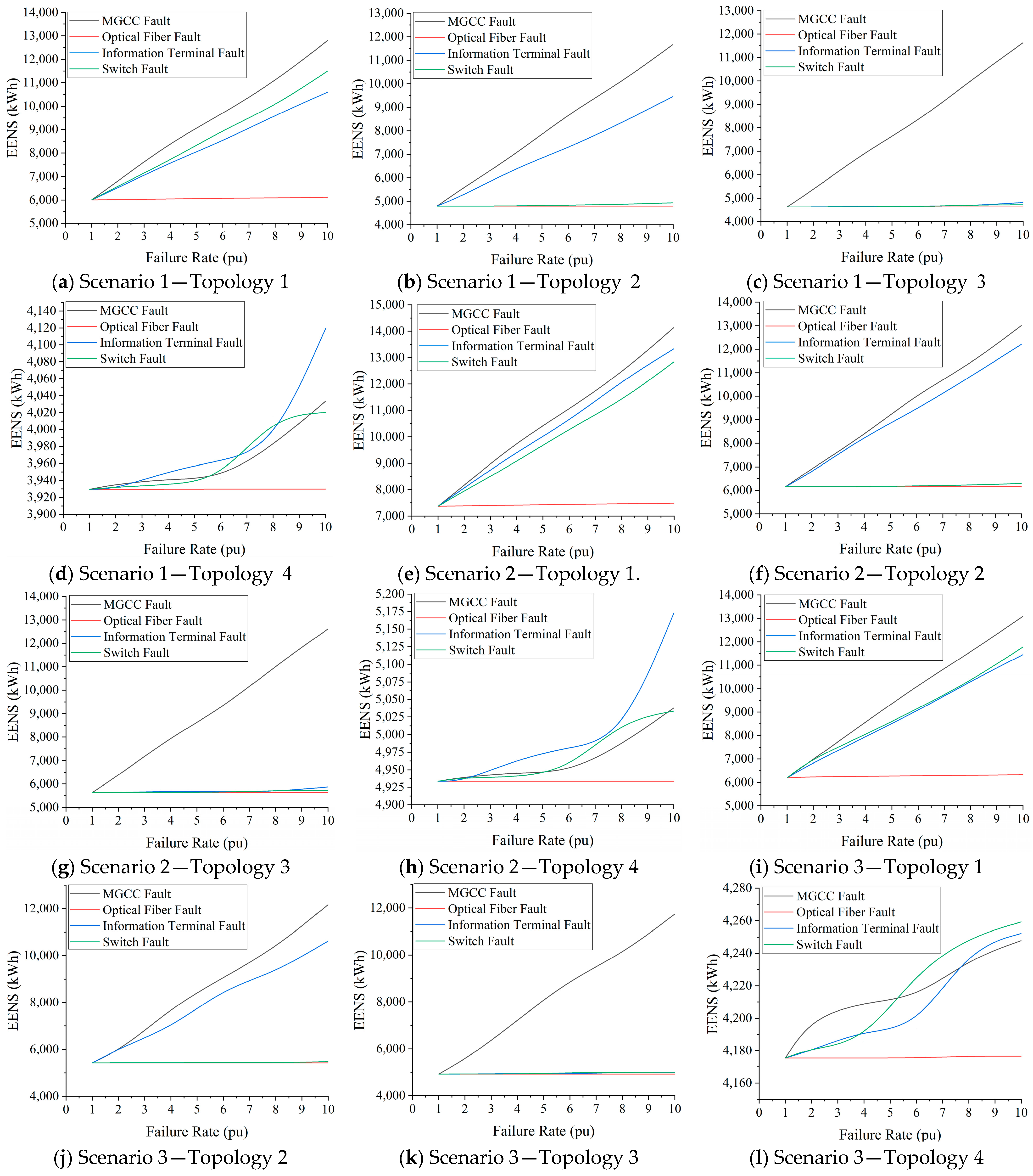
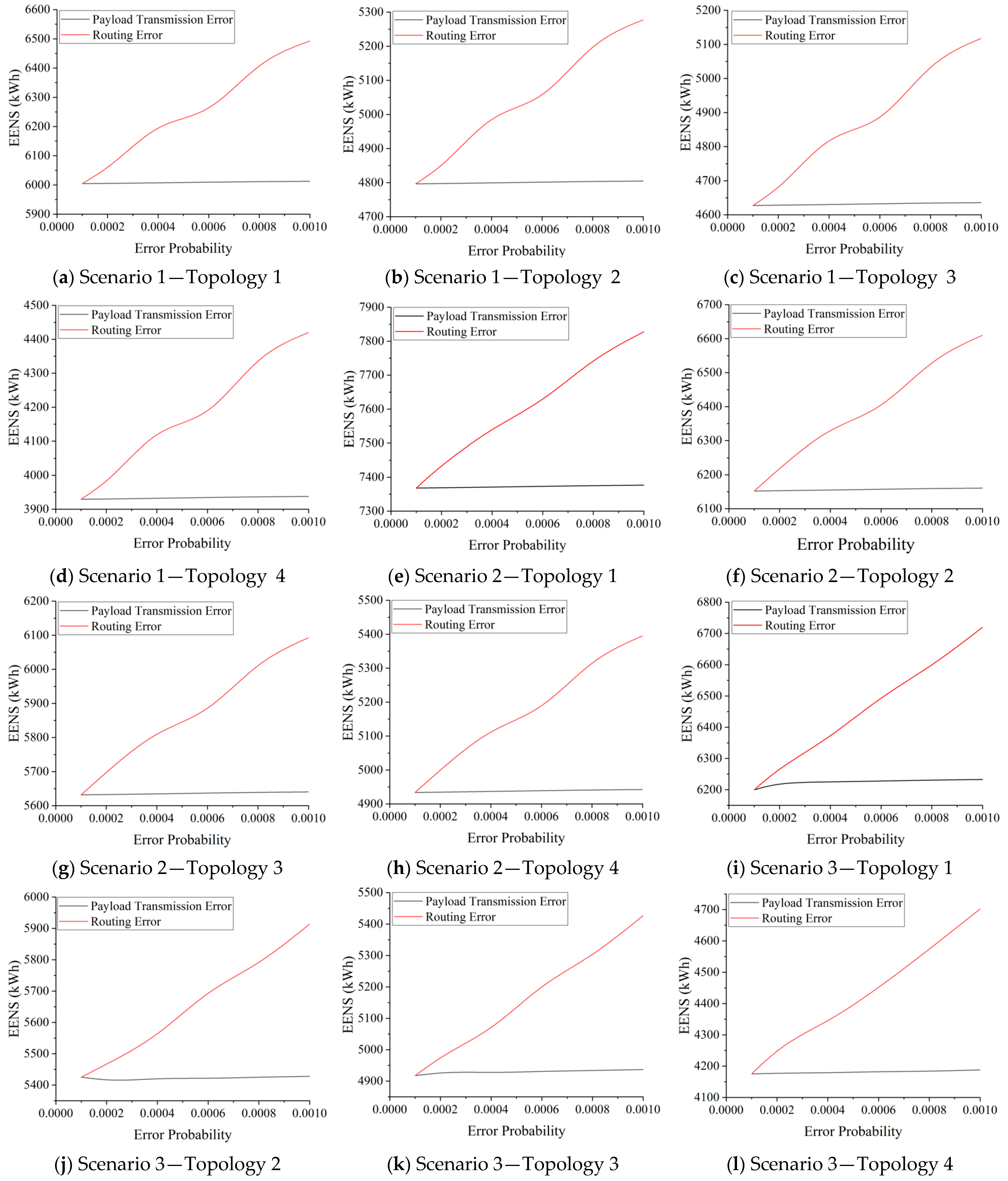

| Various RDERs Scenarios | RDERs Uncertainty | MGCCs Faults | Information Transmission Delay | Routing Error | Information Transmission Error | Cyber Component Failures | Non-MCS Method | MCS Method | Year | References |
|---|---|---|---|---|---|---|---|---|---|---|
| 🗶 | 🗶 | 🗶 | 🗶 | 🗶 | 🗶 | ✓ | Markov Chain Model | 🗶 | 2012 | [17] |
| 🗶 | 🗶 | 🗶 | 🗶 | 🗶 | 🗶 | ✓ | P-Table | 🗶 | 2014 | [18] |
| 🗶 | 🗶 | 🗶 | 🗶 | 🗶 | 🗶 | ✓ | 🗶 | ✓ | 2019 | [13] |
| 🗶 | 🗶 | 🗶 | ✓ | 🗶 | 🗶 | ✓ | Complex Network Theory | 🗶 | 2020 | [21] |
| 🗶 | 🗶 | 🗶 | ✓ | 🗶 | 🗶 | ✓ | 🗶 | ✓ | 2009 | [22] |
| ✓ | ✓ | 🗶 | 🗶 | 🗶 | 🗶 | ✓ | 🗶 | ✓ | 2017 | [14] |
| ✓ | ✓ | 🗶 | 🗶 | 🗶 | 🗶 | ✓ | 🗶 | ✓ | 2016 | [15] |
| 🗶 | ✓ | 🗶 | ✓ | ✓ | ✓ | ✓ | 🗶 | ✓ | 2019 | [16] |
| 🗶 | ✓ | ✓ | 🗶 | 🗶 | 🗶 | ✓ | 🗶 | ✓ | 2020 | [20] |
| ✓ | ✓ | ✓ | ✓ | ✓ | ✓ | ✓ | 🗶 | ✓ | Proposed Method | |
| Time (Hour) | Beta PDF Parameter (α) | Beta PDF Parameter (β) |
|---|---|---|
| 7 | 0.604 | 9.2272 |
| 8 | 1.1985 | 4.8892 |
| 9 | 2.1071 | 3.6774 |
| 10 | 2.8066 | 2.6887 |
| 11 | 3.0563 | 1.8086 |
| 12 | 1.611 | 1.0295 |
| 13 | 2.8231 | 1.2454 |
| 14 | 2.5989 | 1.4137 |
| 15 | 2.7887 | 2.2633 |
| 16 | 2.4427 | 3.4466 |
| 17 | 1.8686 | 5.3861 |
| 18 | 0.9021 | 6.7819 |
| Element | Repair Time (h) | Failure Rate (Failure/Year) |
|---|---|---|
| MGCC | 48 | 0.25 |
| Network switch | 48 | 0.2 |
| Optical fiber | 4 | 0.0175 |
| Information terminal | 24 | 0.658 |
| MGT | 100 | 1.168 |
| PV | 40 | 0.5 |
| WT | 279 | 0.769 |
| ESS | 7.8 | 0.172 |
| Parameters | Values |
|---|---|
| Probability of the payload error | 0.0001 |
| Payload error deviation | 0.01 |
| Probability of the routing error | 0.0001 |
| Routing error deviation | 0.01 |
| Average information transmission delay | 1 s |
| Maximum tolerable delay margin of information transmission | 6 s |
| Scenario No. | Topology No. | With Cyber Impacts | Without Cyber Impacts | ||||
|---|---|---|---|---|---|---|---|
| EENS (kWh/Year) | LOLP (%) | SAIDI (Hour) | EENS (kWh/Year) | LOLP (%) | SAIDI (Hour) | ||
| Scenario 1 (WT-100) | 1 | 6004.5 | 1.6481 | 89.71 | 3868.5 | 1.1215 | 55.726 |
| 2 | 4796.4 | 1.4142 | 73.571 | ||||
| 3 | 4627.4 | 1.2761 | 68.616 | ||||
| 4 | 3929.5 | 1.151 | 57.656 | ||||
| Scenario 2 (PV-100) | 1 | 7368 | 1.7468 | 110.1 | 4871.7 | 1.1986 | 71.165 |
| 2 | 6152.2 | 1.5307 | 94.281 | ||||
| 3 | 5631.7 | 1.3525 | 83.59 | ||||
| 4 | 4933.8 | 1.2274 | 72.63 | ||||
| Scenario 3 (WT-50/PV-50) | 1 | 6199.7 | 1.7771 | 95.523 | 4125.1 | 1.2478 | 61.68 |
| 2 | 5425.5 | 1.5854 | 81.748 | ||||
| 3 | 4917.7 | 1.4148 | 74.266 | ||||
| 4 | 4175.5 | 1.2829 | 62.704 | ||||
| Scenario No. | Topology No. | EENS Increment Due to Cyber Impacts (kWh/Year) | EENS Decrement Compared to Cyber Network Topology 1 (%) | LOLP Increment due to Cyber Impacts (%) | Decrement Compared to Cyber Network Topology 1 (%) |
|---|---|---|---|---|---|
| Scenario 1 (WT-100) | 1 | 2136.0 | - | 0.5266 | - |
| 2 | 927.9 | 56.5590 | 0.2927 | 44.4170 | |
| 3 | 758.9 | 64.4710 | 0.1546 | 70.6419 | |
| 4 | 61 | 97.1442 | 0.0295 | 94.3980 | |
| Scenario 2 (PV-100) | 1 | 2496.3 | - | 0.5482 | - |
| 2 | 1280.5 | 48.7041 | 0.3321 | 39.4199 | |
| 3 | 760 | 69.5549 | 0.1539 | 71.9263 | |
| 4 | 62.1 | 97.5123 | 0.0288 | 94.7464 | |
| Scenario 3 (WT-50/PV-50) | 1 | 2074.6 | - | 0.5293 | - |
| 2 | 1300.4 | 37.3180 | 0.3376 | 36.2176 | |
| 3 | 792.6 | 61.7950 | 0.1670 | 68.4489 | |
| 4 | 50.4 | 97.5706 | 0.0351 | 93.3686 |
| Scenario No. | Topology No. | With Cyber Impacts | ||
|---|---|---|---|---|
| EENS (kWh/Year) | LOLP (%) | SAIDI (Hour) | ||
| Scenario 1 (WT-100) | 1 | 5277.8 | 1.5145 | 78.007 |
| 2 | 4075.4 | 1.2773 | 61.581 | |
| 3 | 3929.5 | 1.151 | 57.656 | |
| 4 | 3929.5 | 1.151 | 57.656 | |
| Scenario 2 (PV-100) | 1 | 6641 | 1.6132 | 98.393 |
| 2 | 5431.3 | 1.3938 | 82.291 | |
| 3 | 4933.8 | 1.2274 | 72.63 | |
| 4 | 4933.8 | 1.2274 | 72.63 | |
| Scenario 3 (WT-50/PV-50) | 1 | 5481.7 | 1.6476 | 84.682 |
| 2 | 4645 | 1.4436 | 70.387 | |
| 3 | 4175.5 | 1.2829 | 62.704 | |
| 4 | 4175.5 | 1.2829 | 62.704 | |
| Scenario No. | Topology No. | Inaccuracies in Reliability Indices Due to Non-Consideration of MGCC Faults | ||
|---|---|---|---|---|
| EENS (kWh/Year) | LOLP (%) | SAIDI (Hour) | ||
| Scenario 1 (WT-100) | 1 | 726.7 | 11.703 | 0.13 |
| 2 | 721 | 11.99 | 0.14 | |
| 3 | 697.9 | 10.96 | 0.13 | |
| 4 | 0 | 0 | 0 | |
| Scenario 2 (PV-100) | 1 | 727 | 11.707 | 0.13 |
| 2 | 720.9 | 11.99 | 0.14 | |
| 3 | 697.9 | 10.96 | 0.13 | |
| 4 | 0 | 0 | 0 | |
| Scenario 3 (WT-50/PV-50) | 1 | 718 | 10.841 | 0.13 |
| 2 | 780.5 | 11.361 | 0.14 | |
| 3 | 742.2 | 11.562 | 0.13 | |
| 4 | 0 | 0 | 0 | |
Publisher’s Note: MDPI stays neutral with regard to jurisdictional claims in published maps and institutional affiliations. |
© 2021 by the authors. Licensee MDPI, Basel, Switzerland. This article is an open access article distributed under the terms and conditions of the Creative Commons Attribution (CC BY) license (https://creativecommons.org/licenses/by/4.0/).
Share and Cite
Aslani, M.; Hashemi-Dezaki, H.; Ketabi, A. Reliability Evaluation of Smart Microgrids Considering Cyber Failures and Disturbances under Various Cyber Network Topologies and Distributed Generation’s Scenarios. Sustainability 2021, 13, 5695. https://doi.org/10.3390/su13105695
Aslani M, Hashemi-Dezaki H, Ketabi A. Reliability Evaluation of Smart Microgrids Considering Cyber Failures and Disturbances under Various Cyber Network Topologies and Distributed Generation’s Scenarios. Sustainability. 2021; 13(10):5695. https://doi.org/10.3390/su13105695
Chicago/Turabian StyleAslani, Mehrdad, Hamed Hashemi-Dezaki, and Abbas Ketabi. 2021. "Reliability Evaluation of Smart Microgrids Considering Cyber Failures and Disturbances under Various Cyber Network Topologies and Distributed Generation’s Scenarios" Sustainability 13, no. 10: 5695. https://doi.org/10.3390/su13105695






